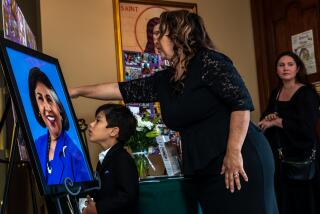Fidel’s slow fade
In the early ‘90s, when I was living in Havana with my family, my eldest daughter, Bella, who was then about 6 years old, came home from school one afternoon in a state of excitement. She asked me, in Spanish: “Daddy, do you know what ‘amor’ means?” I feigned ignorance. Taking a deep breath, Bella recited: “Amor es lo que Fidel siente para el pueblo” -- “Love is what Fidel feels for the people.”
Careful not to show my dismay, I congratulated Bella on her feat of memorization, and she beamed with pride. She was, understandably, very pleased with her educational achievement.
The Havana primary school that Bella attended was the Eliseo Reyes, named after one of the Cuban guerrilla fighters who accompanied Ernesto “Che” Guevara on his final expedition to Bolivia and who died with him there, fighting for the cause of Marxist revolution. Posted over the school’s front door was a wood sign that read Muerte a Traidores -- Death to Traitors.
Bella’s school primer had little symbols illustrating each letter of the alphabet. “F,” for instance, symbolized “fusil” (rifle), and “T” stood for “tank.” The book was sprinkled with Fidel’s sayings on the importance of education, study and revolutionary duty. There were pictures too. One depicted a youthful Fidel riding into Havana on a tank. Another showed him in the heat of battle, commanding Cuban troops during the Bay of Pigs invasion in 1961. In the schoolbook, Fidel Castro was always referred to simply as “Fidel.”
Inevitably, during the three years we lived in Cuba, Fidel became both a familiar figure and a totemic one to my children -- half grandfather, half God. With his deeds and aphorisms the stuff of daily fare, and his face and voice omnipresent on nightly television, they came to understand that El Jefe Maximo was the ultimate guiding hand that controlled their lives and those of everyone around them. He represented the past and the present, and the future too. Fidel, somehow, was Cuba.
Now, it seems, Fidel Castro is resigning. Illness and age already have forced him to step back from the public stage he occupied for nearly half a century, to fade away in an extended hermitage that has gone on since July 2006. Except for the mostly hushed manner of his prolonged farewell, it has seemed fitting that Fidel would take his leave in the same way he has lived his life, as a long, drawn-out epic. By not appearing in public, by disappearing and yet not disappearing, he remained, of course, the center of attention in Cuba, as he always had been.
If survival were a virtue, then Fidel Castro would be very virtuous indeed, because he has been with us for an extremely long time. In 1957, when Fidel was in the Sierra Maestra fighting the Cuban dictator Fulgencio Batista, Dwight D. Eisenhower was the American president, and the United States still had only 48 states. During the two years that Fidel’s guerrilla war lasted, the Soviets launched Sputnik into space, Detroit launched the Ford Edsel, and “Leave it to Beaver” premiered on American television.
Fidel seized power in January 1959; he went on to become the longest-serving political leader in the world, outlasting not only nine American presidents but his main ideological and financial sponsor, the Soviet Union, as well. Communism collapsed, but Fidel didn’t.
Over the decades, Fidel has left his mark far beyond the shores of Cuba. From his early rupture with the United States, his embrace of socialism and his alliance with the Soviet Union -- which led to the Bay of Pigs invasion and then to the Cuban missile crisis -- to his long-term sponsorship of Marxist revolution in Latin America and Africa, Fidel’s challenge to U.S. hegemony abroad ultimately redefined the Cold War.
Fidel’s international political relevance may have dwindled since the days of superpower confrontation, but his very survival made him one of the world’s elder statesmen, and also one of its most widely admired. The U.S. trade embargo on Cuba -- a bully-boy legacy of the Cold War that is now 46 years old to the month and counting -- has only added to Fidel’s cheering section, as well as inspiring others to follow his “Mouse That Roared” example. Most prominent among them is Venezuela’s president, Hugo Chavez, who has made it abundantly clear that he intends to emulate Fidel by vigorously defying U.S. policies, in Venezuela and around the world.
At home in Cuba, meanwhile, Fidel’s revolution has been a political, social and economic experiment that has arguably succeeded in some ways and failed disastrously in many others, guaranteeing that his domestic legacy will be both contentious and, perhaps, as long lasting as his rule.
There are many Cubans who are genuinely devoted to Fidel and who dread the uncertainties his eventual death will bring. His younger brother, Raul, has quietly assumed his anointed role as Fidel’s successor. This has already provided a sort of continuity, but Raul’s advanced age of 76 means that he will be only a transitional figure, and so Cuba’s future remains an open question.
There are also many other Cubans who have dreamed for years of Fidel’s demise, convinced that fate has dealt them a heavy hand by turning over their lives to this particularly obstinate, egocentric and durable man. Under Fidel, their lives have been spent in a kind of suffocating reality warp, a uniquely Cuban realm in which time simultaneously stands still and progresses, see-sawing among dramatic episodes linked inextricably to Fidel’s whim and will. Because Fidel has always seen himself, his countrymen and Cuba itself as engaged in a heroic struggle -- for socialism, against imperialism, in defense of national sovereignty and so on -- it has been, somehow, so. Because of his constant exaltation of the Cuban humdrum as vital to the ongoing struggle for the survival of the revolution, there is a collective sense of significance to everyday life in Cuba.
In 2005, for instance, after Fidel launched a national energy-saving campaign, his government imported a huge quantity of Chinese pressure cookers and began to distribute them to Cubans at subsidized prices. Thereafter, Fidel gave speech after televised speech explaining Cuba’s energy woes and arguing that the pressure cookers’ fuel efficiency made their purchase a virtual patriotic duty. It is hard to imagine anyone but Fidel being able to turn a kitchen appliance into an item of urgent national priority, but he managed it.
With similar degrees of passion dedicated by Fidel to everything from mosquito-eradication drives -- “the battle against dengue” -- to the battle to “preserve the conquests of socialism,” daily existence came to feel at once portentous and, often, very desolate for Cubans, because skirmishes in the great revolution are endless and the perfect future never seems to arrive.
As Fidel has withdrawn, not only his loyalists miss him but, I suspect, his opponents too. With the eclipse of Fidel’s era, so too passes the shared epic quality of their own lives, however much they have suffered. The next blow will be Fidel’s death, and inevitably, the downsizing of history in Cuba and, perhaps, of Cuba itself. If for the last 49 years Fidel was Cuba, what will Cuba be without him?
Every Cuban understands that Fidel’s resignation, even Fidel’s death, will not necessarily end their nation’s long standoff with the United States and that, in one way or another, Cuba’s future will be, as it has always been, shaped directly or indirectly by decisions made in Washington.
A couple of years ago, Caleb McCarry, the Bush administration’s appointee to the post of “Cuba transition coordinator,” told me that even if Raul Castro took steps to open up Cuba’s economy, such as China has done, it wouldn’t alter U.S. policy toward Cuba. “Economic freedoms are important,” said McCarry, “but there has to be political freedom too -- multiparty democracy. Ultimately, that is what will help Cubans face the legacy of the dictatorship they’ve lived under and to define a future where reconciliation and freedom is possible. In other words, the solution is a genuine transition which returns sovereignty to the Cuban people, to allow them to decide who their leaders will be.”
Absent that, the administration would “continue to offer a real transition in Cuba, and we will remain firm with the regime.”
Such open talk in Washington about promoting “regime change” strikes most of the Cubans I know, including Fidel’s detractors, as gallingly interventionist. But this is nothing new; such talk is, in fact, as old as Cuba’s nationhood, which was itself brought about by U.S. intervention during the Spanish-American War. With Cuban independence came a mostly unbroken succession of pro-American regimes, some of them cravenly so.
Long before he became a socialist, Fidel was an ardent Cuban nationalist who conceived of his revolution as the restorative antidote to his country’s history of Yankee midwifery. Later, he came to believe that he and his revolution had finally secured full Cuban national sovereignty -- or, as he often referred to it, its “dignity” -- by standing up to the United States and by surviving.
In a conversation we had in 2006, Ricardo Alarcon, the president of Cuba’s National Assembly, suggested that Cuba’s independence was the most important achievement of Fidel and his revolution. But Alarcon also appeared worried that in the future, after Fidel, Cuba’s sovereignty might not be so secure.
He said: “We have a basic dilemma that is kind of unparalleled, and you know why? Because we will always be a small country, and the other one -- yours -- will always be a big one. Big. Independently of whatever problems you might have in Iraq, or with your economy, and all of that, the fact is that you are a great power and Cuba is a small country. These are two realities that you can’t change: the great disproportion between the two nations, and their geographical proximity, which for us is everything.
“You know what our great problem is? That you look, and what you see is an unequal game; you don’t have a way of ever really competing, so all you can do is bet on the idea that someday in the United States, there will be a government that is motivated by other ideas, other attitudes.”
Time will tell. Each of the U.S. presidential candidates responded to Castro’s resignation with a chorus of calls for more freedom in Cuba. Barack Obama said the U.S. should be ready to normalize relations if Havana “begins opening Cuba to meaningful democratic change.” For now, though, after 50 years of revolution and 81 years of life, Fidel is almost gone, and Cuba and the United States remain where they have always been, separated by sea, 90 miles apart.
Jon Lee Anderson is a staff writer for the New Yorker. He is the author of several books, among them “The Fall of Baghdad” and “Che Guevara: A Revolutionary Life.”
More to Read
Start your day right
Sign up for Essential California for news, features and recommendations from the L.A. Times and beyond in your inbox six days a week.
You may occasionally receive promotional content from the Los Angeles Times.






